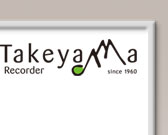 |
 |
 |
 |
 |
|
|
 |
A lot of care needs to be taken in order to draw the best tone out of your instrument and to maintain its condition for a long time. Listed below are the particularly important points.
|

| The first month should be the “playing-in” period.
| |
| |
|
| ● |
What is “playing-in”?
A new recorder is not yet adapted to moisture. Playing it for a long time at once may cause warping, or in rare cases, cracking. Also, as the wood is treated with oil, a new recorder tends to build up droplets in the windway, causing it to "clog".
This is why you need to play-in a new recorder for about a month, though it varies depending on the material. The same procedure has to be followed for an instrument which has not been used for a long time.
|
| ● |
The first week
Warm your recorder to body temperature before playing.
Then play it for up to 15 minutes each day. You should stop playing if you noticed the droplets in the windway causing clogging, even if it is still within the 15 minutes.
|
| ● |
The first month
Play it for gradually longer. At this stage, too, stop playing when you have noticed clogging. The problem of clogging should be reduced by the end of the playing-in period. |
| Even after the playing-in period, care should be taken in order to keep your instrument in best condition and maintain the best tone. |

| Please not play continuously for more than 2 hours at a time.
|
| ● |
As in the playing-in period, warm your recorder up to body temperature before playing.
Even after the playing-in period, playing continuously for a long time leads to a deterioration of the instrument and eventually shortens its life. Although you need to pay attention to the
performance time in winter more than in summer, 2 hours at a time should be the limit.
When you notice clogging, let it rest until the windway is dry.
|

| Please dry the instrument sufficiently.
|
| ● |
Firstly, remove any droplets on the bore with a cloth.
Then let it dry naturally. It is important not to pack it away in the case straight away.
You should also keep it after separating all parts, head joint, middle joint and foot joint. |
| ● |
Apply a very thin layer of olive oil or almond oil to the outside
surface and to the bore of the instrument.
When oiling the bore, push in a small piece (approx. 15cmx15cm) of lint‐free cloth, such as
gauze, soaked in a small amount of oil, on a cleaning rod and rotate the recorder on your lap.
Extra care should be taken when oiling the bore of the head joint not to push the rod
in too much. Never get any oil on to the block.
Avoid oiling when the bore is moist, for example, just after playing. After oiling, leave the
instrument out to dry for a while before playing it again.
|
| ● |
Timing of oiling
Apply oil when the bore got into a dry condition. The frequency of oiling varies depending the material. In general, the instruments made of soft material such as maple have a high frequency of oiling, compared with the ones made of hard material such as rosewood and granadilla.
|
| Adjustment of joint parts
|
|
| ● |
Corked joint
Due to change in humidity, the wood expands and contracts. When you feel that a joint part is tight, please use the cork grease. If you cannot separate a joint part, leave it out without pulling apart forcibly. When a joint part is loose, please contact the dealer which you
purchased it.
|
| ● |
Threaded joint
When putting the instrument together, please turn a joint part to the same direction as
wound thread. Please be careful not to change the turning direction halfway.
If the thread on the joints has become loose, pull out the end, unwind and rewind a few times. This enables recovery of elasticity of the thread and the joint will be back to the original fit. Only if it is still too loose after this process, should you add more thread.
* You can get our original grease for threaded joints at our own shop, Anrieu Recorder
Gallery. |
| |
|

| ● |
Regarding the repair of the instruments, please contact the dealer which you purchased them, in principle.
|
| ● |
The windway and block change setting in the course of use. If it becomes difficult to blow, your recorder needs some adjustments.
|
| ● |
We may not be able to repair the instrument once the modification of the windway, block, finger holes, etc. had been made by another person or party (including yourself).
|
| ● |
Repairs and servicing are principally for our products. Although we could provide consultation for the wooden recorders made by other makers, we cannot guarantee a fully satisfactory result, as we have no spare parts, for example block, and we have no information on the materials used, production process, nor the intention of the original maker. We kindly ask for your understanding.
|
|
|
 |









